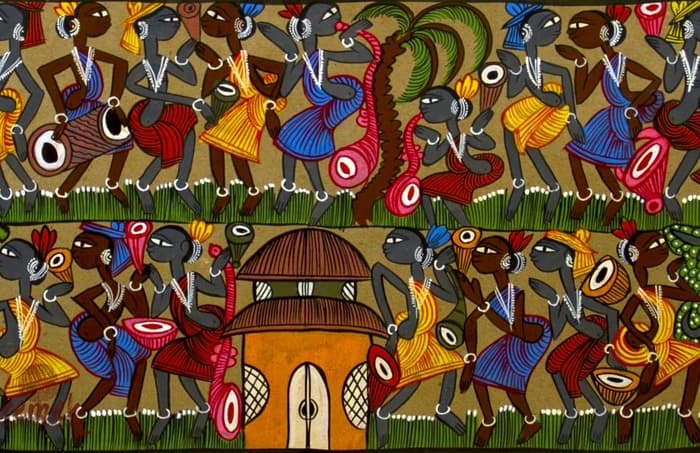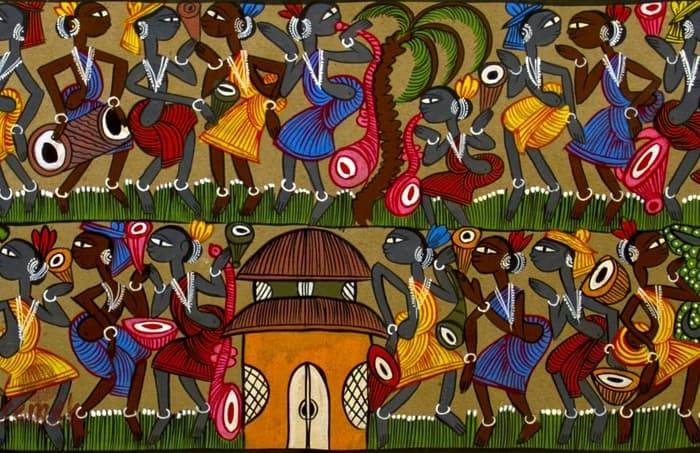Introduction:
India, a land of myriad cultures and traditions, boasts a vibrant tapestry of visual arts that reflects its rich heritage and diverse cultural landscape. From the ancient cave paintings of Ajanta and Ellora to the avant-garde contemporary art scenes of Mumbai and Delhi, Indian art forms have evolved over centuries, leaving an indelible mark on the global cultural landscape. In this comprehensive exploration, we delve into the various art forms within the realm of visual arts in India, tracing their origins, evolution, and profound impact on both the local and global stage.

Folk Art: The Soul of Indian Culture
Folk art forms the bedrock of Indian visual culture, encapsulating the essence of indigenous traditions and beliefs. From the intricate Madhubani paintings of Bihar to the vibrant Warli art of Maharashtra, each region of India boasts its own distinctive folk art tradition. These art forms, passed down through generations, not only serve as a means of artistic expression but also as a repository of cultural heritage. The vivid colors, bold motifs, and rhythmic patterns of folk art are a celebration of life, reflecting the joys, sorrows, and rituals of everyday existence. Despite the onslaught of modernity, folk art continues to thrive, providing a vital link to India’s cultural roots and inspiring contemporary artists to explore new avenues of creativity.
The Influence of Folk Art on Contemporary Indian Artists:
The influence of folk art on contemporary Indian artists cannot be overstated. Many modern artists draw inspiration from traditional folk motifs, incorporating them into their own work to create a unique synthesis of past and present. For example, the celebrated artist Bharti Kher often incorporates elements of Warli art into her sculptures and installations, reinterpreting traditional symbols in a contemporary context. Similarly, the painter Thota Vaikuntam infuses his canvases with the vibrant colors and fluid lines of Telangana folk art, creating striking portraits that capture the essence of rural life in India. By paying homage to their cultural heritage, these artists not only preserve the legacy of folk art but also infuse it with new meaning and relevance for contemporary audiences.
Classical Art: Preserving Tradition Amidst Modernity
Classical art forms such as Bharatanatyam, Kathak, and Odissi are integral components of India’s cultural identity, embodying centuries-old traditions of dance, music, and storytelling. Rooted in ancient texts and scriptures, these art forms have been meticulously preserved and passed down through generations of practitioners. Their graceful movements, intricate gestures, and emotive expressions serve as a testament to the enduring power of tradition in a rapidly changing world. Moreover, classical art forms serve as a source of inspiration for contemporary artists, who draw upon their timeless aesthetics to create new and innovative works that resonate with audiences both at home and abroad.
The Evolution of Classical Dance:
While classical dance forms like Bharatanatyam and Kathak have deep roots in tradition, they have also evolved over time to reflect changing social mores and artistic sensibilities. For example, contemporary choreographers such as Mallika Sarabhai and Astad Deboo have reimagined classical dance by infusing it with elements of modernity and experimentation. Sarabhai’s groundbreaking work, “Sita’s Daughters,” combines classical Bharatanatyam with contemporary themes of gender equality and women’s empowerment, challenging conventional notions of femininity and power. Similarly, Deboo’s innovative blend of Kathak and contemporary dance forms has earned him international acclaim, bringing classical Indian dance to new audiences around the world. By embracing innovation while staying true to tradition, these artists ensure that classical dance remains relevant and vibrant in the 21st century.
Paintings: Capturing the Essence of India’s Diverse Culture
Painting has long been a cornerstone of Indian visual arts, encompassing a wide array of styles, techniques, and themes. From the exquisite miniature paintings of Rajasthan to the bold abstract canvases of the Progressive Artists Group, Indian painters have continuously pushed the boundaries of artistic expression, blending tradition with innovation to create works of unparalleled beauty and complexity. Moreover, paintings serve as a visual chronicle of India’s tumultuous history, documenting the rise and fall of empires, the ebb and flow of cultures, and the enduring spirit of resilience and creativity. In recent years, Indian painters have gained international acclaim, with their works being exhibited in prestigious galleries and museums around the world, thereby elevating India’s cultural profile on the global stage.
The Impact of Indian Paintings on Global Art Movements:
Indian paintings have had a profound impact on global art movements, influencing artists and collectors alike with their distinctive style and subject matter. During the colonial period, European artists such as William Hodges and Thomas Daniell were captivated by the scenic beauty of India, producing stunning landscapes and portraits that romanticized the country’s exotic allure. Later, the emergence of the Bengal School led by artists like Abanindranath Tagore and Nandalal Bose sparked a renaissance in Indian art, inspiring Western artists such as Paul Klee and Wassily Kandinsky to explore new forms of expression and spirituality. Today, Indian painters continue to push the boundaries of artistic innovation, experimenting with new mediums and techniques while staying true to their cultural heritage. By bridging the gap between East and West, Indian paintings contribute to a global dialogue on art and culture, enriching the world with their beauty and diversity.
Contemporary Art: Breaking Boundaries and Embracing Diversity
The contemporary art scene in India is a dynamic and eclectic mix of styles, themes, and mediums, reflecting the country’s complex social, political, and cultural realities. From the provocative installations of Subodh Gupta to the whimsical sculptures of Bharti Kher, Indian contemporary artists are unafraid to tackle pressing issues such as identity, globalization, and environmental degradation, challenging conventional notions of art and society. Moreover, the advent of digital technology has enabled artists to explore new forms of expression, blurring the lines between the virtual and the real. As India continues to assert its presence on the global stage, its contemporary artists are playing an increasingly influential role in shaping the discourse surrounding art and culture, offering fresh perspectives and innovative solutions to the pressing challenges of our time.
The Rise of Indian Contemporary Art:
In recent decades, Indian contemporary art has emerged as a major force in the global art world, garnering attention for its bold experimentation and cutting-edge creativity. Artists such as Subodh Gupta, Bharti Kher, and Atul Dodiya have gained international acclaim for their thought-provoking works that address issues ranging from consumerism and urbanization to gender and identity. Moreover, Indian contemporary art has found a receptive audience in the West, with galleries and museums around the world showcasing the works of Indian artists alongside their Western counterparts. This growing recognition has not only elevated the profile of Indian art but also challenged prevailing stereotypes and misconceptions about Indian culture and society. By embracing diversity and breaking boundaries, Indian contemporary artists are redefining the global art scene, offering fresh insights and perspectives that resonate with audiences across continents.
Conclusion:
In conclusion, the visual arts in India represent a kaleidoscope of creativity, diversity, and innovation, spanning millennia of history and encompassing a multitude of styles, techniques, and traditions. From the rustic charm of folk art to the cutting-edge experimentation of contemporary art, Indian artists continue to push the boundaries of artistic expression, inspiring audiences both at home and abroad. As India undergoes rapid socio-economic transformation

